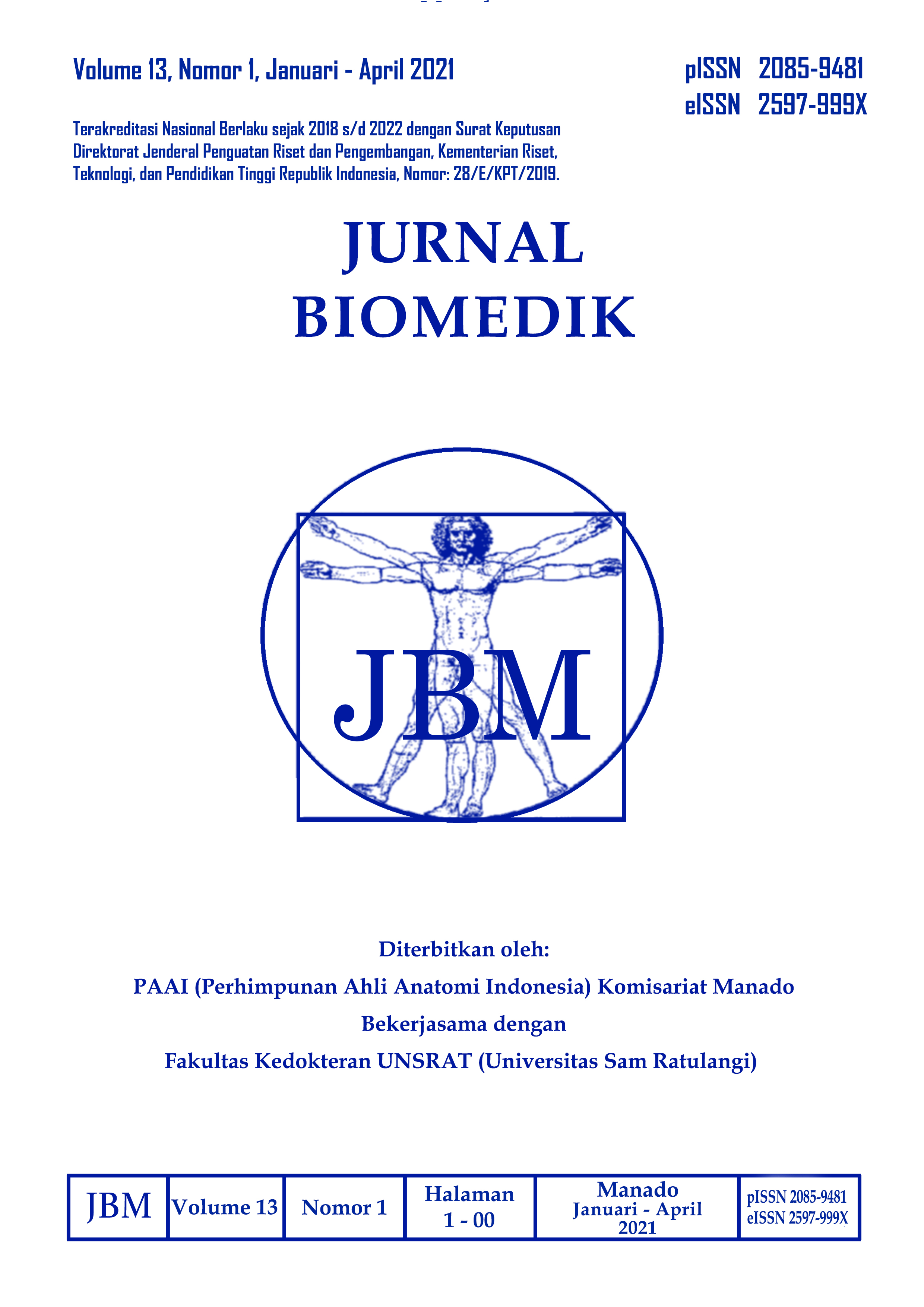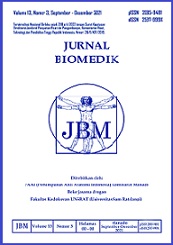Hubungan Antara Parameter Geometrik Sagital Lumbosakral Dengan Kejadian Hernia Nukleus Pulposus Pada Pasien Yang Dilakukan Pemeriksaan MRI Lumbosakral
DOI:
https://doi.org/10.35790/jbm.13.1.2021.32080Abstract
Abstract: The research aimed at analyzing the relationship between the lumbosacral sagittal geometric parameter and the herniated nucleus pulposus incident in the patients undergoing the lumbosacral MRI examination. The research was conducted in the Radiological Installation of Doctor Wahidin Sudirohusodo Hospital, Makassar from February to April 2020. Samples were as many as 65 patients. The data were analyzed using Spearman's correlation and Chi-square tests. The research result indicates that there is the significant relationship between the global lumbosacral angle (p=0.020, r=0.287), sacral table angle (p=0.018, r=0.292), lumbar sagittal balance axis (p=0.011, r=0.313), age (p=0.004, r=0.354) and the herniated nucleus pulposus incident. The smaller the global lumbosacral angle, the higher the herniated nucleus pulposus degree. The greater the sacral table angle and lumbar sagittal balance axis, the higher the herniated nucleus pulposus degree. The greater the age (old), the higher the herniated nucleus pulposus degree. There is no significant relationship between the sacral kyphosis angle (p=0.127), sex (p=0.717), body mass index (p=0.220) and the herniated nucleus pulposus incident. However, there is the tendency that the smaller the sacral kyphosis angle, the higher the herniated nucleus pulposus degree. There is also the tendency that the greater the body mass index, the higher the herniated nucleus pulposus degree.
Key words: Global lumbosacral angle, sacral table angle, sacral kyphosis angle, lumbar sagittal balance axis, age, sex, body mass index, herniated nucleus pulposus
Â
Abstrak: Penelitian ini bertujuan menganalisis hubungan antara parameter geometrik sagital lumbosakral dengan kejadian hernia nukleus pulposus pada pasien yang dilakukan pemeriksaan MRI lumbosakral. Penelitian ini dilaksanakan di Instalasi Radiologi Rumah Sakit Dokter Wahidin Sudirohusodo Makassar mulai bulan Februari sampai dengan bulan April 2020. Jumlah sampel sebanyak 65 pasien. Metode yang digunakan adalah Uji korelasi Spearman dan Chi Square. Hasil penelitian menunjukkan ada hubungan yang bermakna antara sudut global lumbosacral (p=0,020, r=-0,287), sudut sacral table (p=0,018, r=0,292), lumbar sagittal balance axis (p=0,011, r=0,313), umur (p=0,004, r=0,354) dengan kejadian hernia nukleus pulposus. Semakin kecil sudut global lumbosacral maka semakin tinggi derajat hernia nukleus pulposus. Semakin besar sudut sacral table dan lumbar sagittal balance axis maka semakin tinggi derajat hernia nukleus pulposus. Semakin bertambah umur (tua) maka semakin tinggi derajat hernia nukleus pulposus. Tidak ada hubungan yang bermakna antara sudut sacral kyphosis (p=0,127), jenis kelamin (p=0,717), indeks massa tubuh (p=0,220) dengan kejadian hernia nukleus pulposus. Namun, terlihat kecenderungan bahwa semakin kecil sudut sacral kyphosis maka semakin tinggi derajat hernia nukleus pulposus. Terlihat juga kecenderungan bahwa semakin besar indeks massa tubuh maka semakin tinggi derajat hernia nukleus pulposus.
Kata Kunci: Sudut global lumbosacral, sudut sacral table, sudut sacral kyphosis, lumbar sagittal balance axis, umur, jenis kelamin, indeks massa tubuh, hernia nukleus pulposus
Downloads
Additional Files
Published
Issue
Section
License
Penyunting menerima sumbangan tulisan yang BELUM PERNAH diterbitkan dalam media lain. Naskah yang masuk dievaluasi dan disunting keseragaman format istilah dan cara penulisan sesuai dengan format penulisan yang terlampir dalam jurnal ini.
Segala isi dan permasalahan mengenai tulisan yang yang diterbitkan dalam jurnal menjadi tanggung jawab penuh dari penulis.







